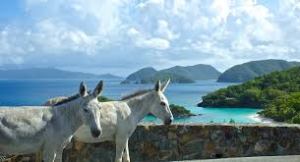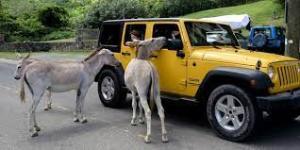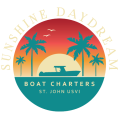Exploring the Feral Donkeys of St. John: A Historical Perspective on Their Presence and Influence
Donkeys have played a significant role in the history of St. John, a beautiful island in the U.S. Virgin Islands. During the colonial era when St. John was under Danish rule, donkeys were brought to the island to assist with various tasks such as transportation of goods and agricultural work. Their strong build and ability to navigate the rugged terrain made them ideal for the island’s needs.
As St. John developed, the donkeys became an integral part of daily life. They carried heavy loads of crops, firewood, and other essential items, enabling the island’s economy to thrive. Donkeys also provided transportation for residents, who relied on them to traverse the hilly landscapes and narrow trails.
However, with the advent of modern technology and improved transportation methods, the need for donkeys declined. Trucks, cars, and other mechanized vehicles took over the tasks once performed by donkeys, leading to a decrease in their utilization. Many donkeys were left to roam freely on the island, becoming feral over time.

Donkeys enjoying the view from Trunk Bay overlook
Despite their feral status, the donkeys on St. John continued to make an impact on the island’s culture and environment. They adapted to the local conditions and formed small herds that roamed the hills and beaches. The sight of these free-roaming donkeys became an iconic symbol of St. John, attracting tourists who were fascinated by their presence.
In the early days, encounters with donkeys were common while exploring the island’s trails and roads. Locals and visitors alike marveled at the donkeys’ ability to survive in the wild and appreciated their role in shaping the island’s history. The donkeys became a beloved part of St. John’s charm and were cherished as a unique aspect of the island’s identity.
However, as the island’s population grew and infrastructure developed, conflicts arose between the feral donkeys and human activities. Donkeys would sometimes wander onto private property, damaging gardens and crops. Their presence on the roads posed a hazard, leading to occasional accidents.

Please don’t feed the donkeys!
To address these challenges, initiatives were undertaken to manage the donkey population on St. John. Some donkeys were relocated to other islands where they could be better accommodated. Sterilization programs were implemented to control population growth, ensuring a more sustainable balance between the donkeys and the island’s resources.
Additionally, collaborations between local authorities and animal welfare organizations focused on providing care and support for the donkeys. These efforts involved regular health checks, veterinary care, and interventions in cases where donkeys were injured or in need of assistance.
Today, while the feral donkeys of St. John continue to be a part of the island’s landscape, their numbers have been carefully managed to minimize conflicts with human activities. Their historical significance and contribution to the island’s heritage are still acknowledged and appreciated.
